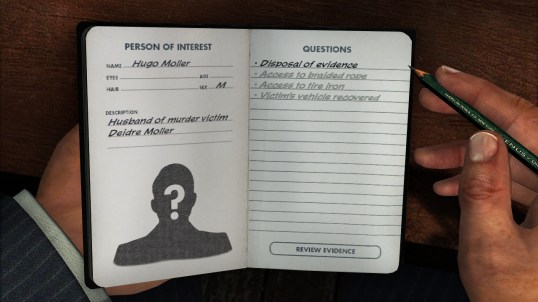Yes, the mechanics of playing are repetitive. Evidence, interview, gunfight/brawl/chase can feel like lather, rinse, repeat. But there’s enough unique texture in each case to keep you engaged. You don’t keep playing to earn high marks; you keep playing to see where the story goes. Testament to that is an option that lets you skip action sequences altogether. You don’t have to shoot it out with thugs in the game, since it’s a foregone conclusion that you’re going to win. You don’t even have to navigate to locations, since you can let your partner drive. The action skip option is a weird choice for a video game whose essence is inherently meant to be played.
However, by letting players opt-out of de rigeur car chases and gunfights, L.A. Noire gives us the chance to dive into something a lot more intriguing. It lets you know what Rockstar and Team Bondi hope to accomplish with L.A. Noire. The priority is to deliver a story and if sneaking around following a suspect proves too hard and gets in the way, then you can move past that and not get penalized. On the other hand, you can never skip an interrogation. That’s the showpiece element in L.A. Noire, and it works well. I found myself having a bit of ego attached to just how well my grilling of suspects went and hated feeling outfoxed by someone who got a lie past me. It’d be a misnomer to call the design architecture of L.A. Noire entirely new. The detective thriller actually gestures backwards in gaming history, riffing on to the text-based adventures and point-and-click games from the medium’s first two decades, but this one adds production values of modern filmmaking and interaction with captured performances.
From the great, gravelly voiceover narration at the beginning of each chapter to the mix of period music and jazzy soundtrack, the new crime thriller also shows off Rockstar’s increasing command of stylistic elements. The writing by Team Bondi’s Brendan McNamara nails the rat-a-tat of tough guy chatter and the visuals feel like an exquisitely designed movie set. You can turn off color for a black-and-white playthrough, too. Narratively, L.A. Noire breaks things up with flashbacks to Phelps’ war days–where we see him trying to become an officer and rivalries with other enlisted men–and lurid parallel plotlines about a Dr. Feelgood-type in the seedy underbelly of postwar L.A.
(More on TIME.com: L.A. Noire Gets L.A. Literary with Official Crime Anthology)


